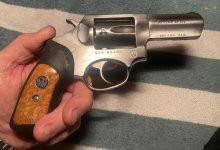Marshall and Sanow looked at multiple hits in their later work.
Their methodology is nonsensical. They deliberately failed to count situations where one shot was fired and it failed to stop someone so that more shots needed to be fired.
How can they possibly claim to calculate one-shot stops when you
deliberately exclude situations where one shot was not enough to effect a stop so that additional shots needed to be fired?
How can you arrive at the percentage of successes without factoring in the number of failures?
But you are also missing the larger point that any research relying on field reported data will have methodological flaws from things like a failure to have a common report form, resulting in different elements being reported or failed to be reported by different agencies.
It is beyond that. They are completely discredited. They were discredited in the 1990s.
Many agencies who Marshall and Sanow claim to have gotten their shootings from have come forward and said that not only did they not provide any information to Marshall & Sanow, and that the shootings that Marshall and Sanow have attributed to them do not match any of the shootings that they have on record.
Marshall and Sanow have zero credibility.
Here are some examples:
The July 1992 Law and Order Magazine has several letters to the editor, as well as a statement by the magazines' editor, further illustrating the lack of truth and serious errors in the Marshall and Sanow's "data". Several papers have been published in the peer reviewed IWBA Wound Ballistics Review which have discussed the lack of credibility of Marshall and Sanow. The review wrote that "It was clear in our review and in from the investigations by others that Marshall & Sanow had lied, fabricated data, and did not follow scientific protocols. Their information is fraudulent and meaningless. Please do not stake your life on this garbage."
In response to Sanow's criticism of the 9mm WW 147 grain JHP bullet, SGT Mike Dunlap, Rangemaster at Amarillo, TX, PD contacted every department for which Sanow claimed poor results with this bullet in his "anti-subsonic" articles. Mike submitted his results to Law and Order: they showed that Sanow had misrepresented what these departments found.
In the November 1992 issue, Law and Order published three letters contradicting Sanow's "data" (p. 90). SGT William Porter, head of the Michigan State Police Marksmanship Unit wrote, "I hope that those who read this article will not be influenced by what Sanow wrote about what happened in the Michigan State Police shooting, because it didn't happen that way." In a note introducing these letters, Bruce Cameron, Editorial Director of Law and Order wrote, concerning Sanow's article, "...we do apologize for printing information that has proven to be in error."
Their work has been refuted by the International Wound Ballistics Association.
Go to
Update your browser to use Google Drive, Docs, Sheets, Sites, Slides, and Forms - Google Drive Help
and download download the 1997 issue, volume 3 number 1 and read pages 26-35 which contain the articles:
Fackler, Martin L., MD.: "Book Review: Street Stoppers: The Latest Handgun Stopping Power Street Results." Wound Ballistics Review, 3(1); 26-31: 1997.
MacPherson, Duncan: "Sanow Strikes (Out) Again." Wound Ballistics Review, 3(1): 32-35; 1997.
and download 1999 volume 4 no 2 which contains the following articles:
Van Maanen, Maarten: "Discrepancies in the Marshall & Sanow 'Data Base': An Evaluation Over Time." Wound Ballistics Review, 4(2); 9-13: Fall, 1999.
Fackler, Martin L., MD.: "Undeniable Evidence." Wound Ballistics Review, 4(2); 14-15: Fall, 1999.
MacPherson, Duncan: "The Marshall & Sanow 'Data' - Statistical Analysis Tells the Ugly Story." Wound Ballistics Review, 4(2); 16-21: Fall, 1999.
Their methodology is nonsensical and their data is grossly inaccurate and made-up.
Marshall and Sanow's work is useless. Utterly, unredeemingly useless.



